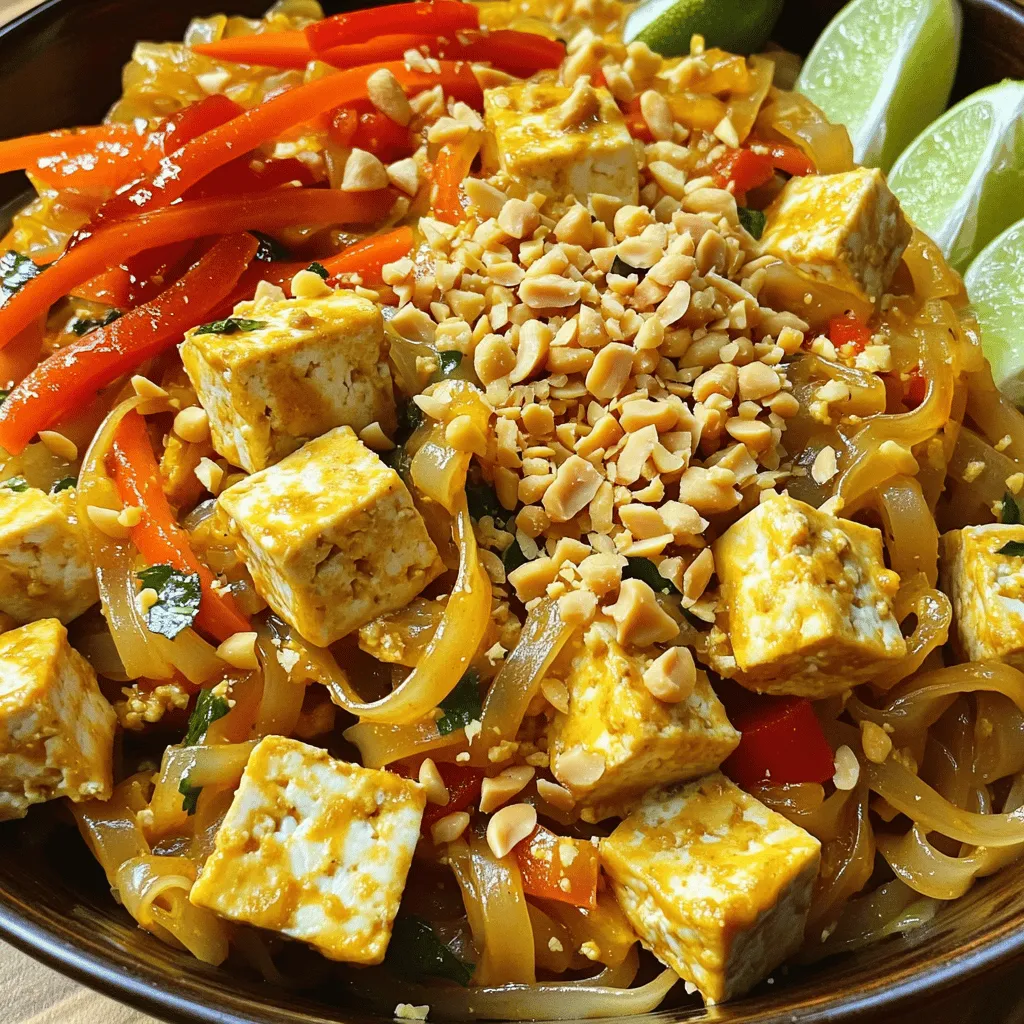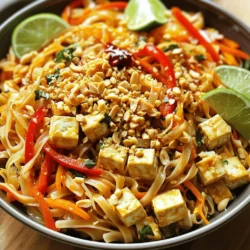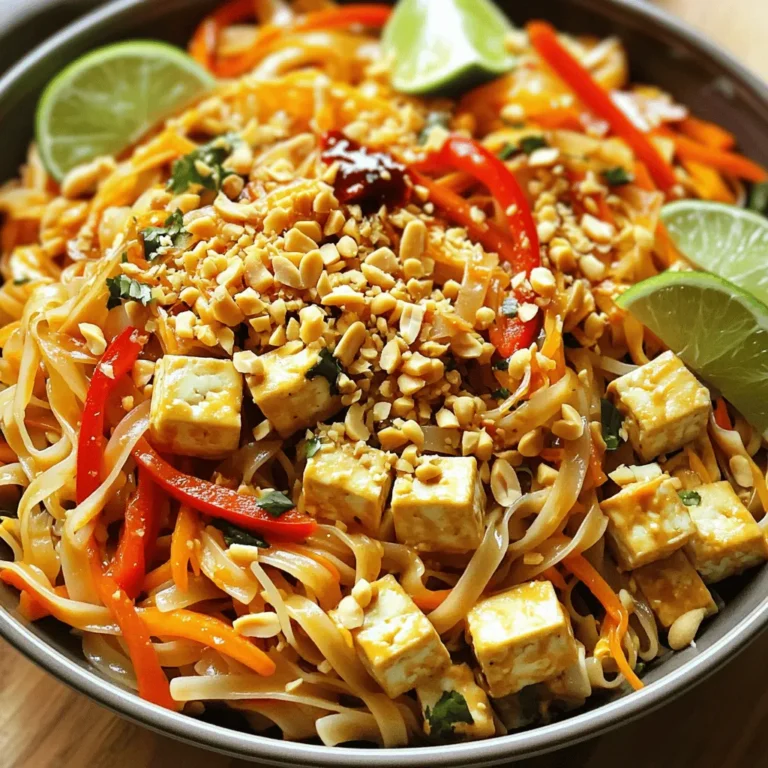Looking for a delicious and easy meal that’s completely vegan? You’re in the right place! My Vegan Pad Thai with Tofu is packed with flavor, simple to make, and sure to impress. In this post, I’ll share everything from ingredient tips to cooking steps, making it easy for you to create this tasty dish at home. Let’s dive in and bring fresh Thai flavors to your kitchen!
Ingredients
Complete ingredient list for Vegan Pad Thai with Tofu
To make Vegan Pad Thai with Tofu, you will need these ingredients:
– 8 oz rice noodles
– 1 block (14 oz) firm tofu, pressed and cubed
– 2 tablespoons vegetable oil
– 3 cloves garlic, minced
– 2 cups bean sprouts
– 1 red bell pepper, thinly sliced
– 1 carrot, julienned
– 2 green onions, chopped
– 3 tablespoons soy sauce (or tamari for gluten-free)
– 2 tablespoons peanut butter
– 1 tablespoon maple syrup
– 1 tablespoon lime juice
– 1 teaspoon Sriracha (or more for heat)
– Crushed peanuts and lime wedges for garnish
Tips for selecting the best tofu
When you pick tofu, look for firm or extra-firm types. These hold their shape well. Check the package date for freshness. Choose tofu that feels smooth and moist. Press it before cooking to remove extra water. This step makes it crispier when you cook it.
Alternatives for ingredients (e.g., gluten-free options)
If you need alternatives, you can use gluten-free soy sauce like tamari. Instead of peanut butter, try almond butter or sunflower seed butter. You can swap rice noodles for zucchini noodles for a low-carb option. If you want more protein, consider using tempeh or seitan. These swaps keep the dish tasty and fun.
Step-by-Step Instructions
How to cook rice noodles perfectly
Cooking rice noodles is easy. Start by boiling water in a large pot. Once the water is bubbling, add the rice noodles. Stir them gently to prevent sticking. Cook for about 4–6 minutes, or until they are tender. Drain the noodles and rinse them under cold water. This stops the cooking process and keeps them from getting mushy. Set the noodles aside for later.
Detailed cooking steps for Vegan Pad Thai with Tofu
1. In a large skillet or wok, heat 2 tablespoons of vegetable oil over medium-high heat.
2. Add the pressed and cubed tofu to the pan. Cook it for 7–10 minutes, turning to brown all sides. Remove the tofu and set it aside.
3. In the same pan, add 3 minced garlic cloves. Sauté for about 30 seconds until fragrant.
4. Now, toss in 1 thinly sliced red bell pepper and 1 julienned carrot. Stir-fry them for about 3 minutes. They should be tender but still crisp.
5. Add the cooked rice noodles and 2 cups of bean sprouts to the pan. Then, return the tofu to the pan.
6. Pour in 3 tablespoons of soy sauce, 2 tablespoons of peanut butter, 1 tablespoon of maple syrup, 1 tablespoon of lime juice, and 1 teaspoon of Sriracha. Stir everything well. Heat through until warm.
7. Finally, fold in 2 chopped green onions and mix.
8. Serve your Vegan Pad Thai hot. Garnish with crushed peanuts and lime wedges for a fresh touch.
Time-saving tips during preparation
Prep your veggies ahead of time. Slice the bell pepper and carrot before you start cooking. Press the tofu while you prepare. This gives it a firmer texture. Also, cook your rice noodles while you sauté the tofu. This way, everything comes together faster. Using a non-stick pan can help you cook with less oil and make cleaning easy.
Tips & Tricks
How to enhance flavor in your vegan pad thai
To make your vegan pad thai pop with flavor, balance is key. Use fresh lime juice for a zesty kick. A dash of soy sauce brings umami depth. Peanut butter adds creaminess and richness. Experiment with Sriracha to find your ideal heat level. Fresh herbs like cilantro or basil can brighten each bite. You can also add a sprinkle of crushed peanuts for extra crunch.
Techniques for perfect tofu texture
Tofu can be bland if not prepared right. Start with firm tofu for the best texture. Press the tofu to remove water. This step helps it absorb flavors. Cut the tofu into even cubes for even cooking. Sauté it in hot oil until golden brown. This creates a nice crust. Avoid overcrowding the pan, as it steams instead of browning.
Serving suggestions and garnishing ideas
Presentation matters! Serve your pad thai in a large bowl for a family-style meal. Add lime wedges on the side for extra zest. Sprinkle crushed peanuts and chopped green onions on top for color and crunch. You can also use fresh herbs like cilantro. For a twist, serve with a side of pickled veggies for a refreshing contrast.

Variations
Adding different vegetables for a customized dish
You can change the veggies in your vegan Pad Thai. Broccoli, snap peas, or zucchini add great color and taste. Just chop them up and toss them in with the other ingredients. You can also use mushrooms for a nice, earthy flavor. Mix and match to find your favorite combo.
Making it spicier or milder
If you want more heat, add more Sriracha or some red pepper flakes. You can also use fresh chili peppers for an extra kick. If you prefer it milder, skip the Sriracha or use less. A dash of coconut milk can also cool it down if it gets too spicy. Adjust the heat to fit your taste.
Protein alternatives for variety
Tofu is great, but you can use other proteins too. Tempeh is a nice choice. It has a nutty taste and a firmer texture. Seitan works well for those who love a meaty bite. You can also try chickpeas for a fun twist. Each option brings its own flavor and texture to the dish. Feel free to experiment and find what you enjoy the most.
Storage Info
Best practices for storing leftovers
To keep your Vegan Pad Thai fresh, store it in an airtight container. Make sure it cools before sealing. Place it in the fridge for up to three days. This helps keep the flavors strong and the texture nice. If you plan to eat it later, avoid adding fresh green onions until serving.
How to reheat Vegan Pad Thai without losing texture
When reheating, use a pan over low heat. Add a splash of water or vegetable broth to prevent sticking. Stir gently to warm it evenly. Avoid using a microwave if you can. It can make the noodles too soft. The goal is to keep that perfect bite while warming the dish.
Freezing tips for meal prep
If you want to freeze your Vegan Pad Thai, portion it out first. Use freezer-safe containers, leaving some space for expansion. You can freeze it for up to one month. When ready to eat, thaw it overnight in the fridge. Reheat it on the stove, adding a bit of liquid to retain its texture.
FAQs
What can I substitute for soy sauce in Vegan Pad Thai?
You can use tamari as a great substitute for soy sauce. Tamari is gluten-free and has a similar taste. If you want a lighter option, try coconut aminos. This adds saltiness and a hint of sweetness. You can also mix vegetable broth with a bit of salt for a milder flavor.
Can I make this dish in advance?
Yes, you can make Vegan Pad Thai in advance. Cook the noodles and veggies, then store them separately. Keep the sauce in a jar. When you’re ready to eat, just heat everything up. Mix in the sauce and enjoy a quick meal. This saves time for busy days.
How can I make Vegan Pad Thai gluten-free?
To make Vegan Pad Thai gluten-free, use rice noodles and tamari. These options are naturally gluten-free. Check the labels on your peanut butter and Sriracha to ensure they are safe. With these swaps, you can enjoy a tasty dish without gluten.
This blog showed you how to make Vegan Pad Thai with Tofu. We covered key ingredients, cooking steps, and useful tips. You learned how to pick the best tofu and how to customize the dish. I shared methods for storing leftovers and reheating for best texture.
Vegan Pad Thai is flexible, so feel free to get creative. Enjoy making this tasty dish!


